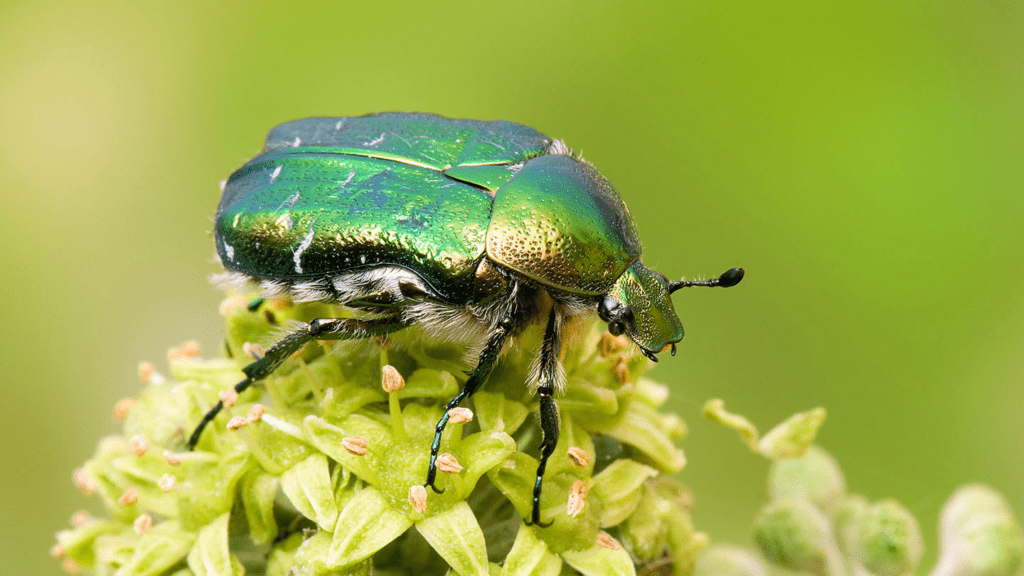
Well over 400,000 species of beetles cavort on our planet. We present a few species that are often found in the garden and are particularly impressive – in both a positive and negative sense.
Contents
Ladybirds and other beneficial insects
As hopeless as the fight against slugs, aphids & co. may often seem – nature has not left us alone. Besides big predators like titmice, hedgehogs or shrews, the pesky garden inhabitants have numerous adversaries who meet them at eye level. Calculations have shown that the offspring of a single female ladybird together consume about 130,000 aphids per growing season.
Resourceful biologists have therefore come up with the idea of marketing the little beneficial insects. Today, you can order the larvae of two-spotted and seven-spotted ladybirds (Adalia and Coccinella, respectively) from mail-order companies to combat aphids. In addition, you can order Australian ladybirds (Cryptolaemus) against mealybugs and mealybugs or ball ladybirds (Chilocorus) against pesky scale insects.
Developmental stages of a seven-spot ladybird
A female lays up to 1500 yellowish eggs in small groups on the underside of leaves. They hatch into 1.5 mm small, predatory larvae that grow to 10 times their size over time. Eventually they turn into a wizened, orange-red pupa from which the beetle (initially without spots) hatches.
Fostering useful beetles: How the little helpers feel at home
In a poison-free, near-natural garden, little helpers present themselves all by themselves, including eager slug-eaters. For example, the larvae of fireflies (small and large fireflies) feed exclusively on the pesky slime, both naked and with a house, during their three- to four-year development period.
The larvae of soft and ground beetles also eat slugs and worms. However, they only settle where they find suitable living conditions. This includes piles of stones, leaves or branches as hiding places for the mostly nocturnal hunters. Fireflies and soft-bodied beetles also need strips of flower meadows in whose root felt they can lay their eggs.
The compost heap in the garden sometimes contains all kinds of hard-to-digest material. Wood scraps and sawdust, for example, or filter paper. Hardly any animal is able to utilise the fibrous cellulose that makes up wood or paper and convert it into valuable compost. The larvae of a few beetle species, however, have this gift.
The somewhat corpulent rhinoceros beetle, up to 4 cm in size, whose males bear the impressive head horns that give it its name, is one of them. A graceful, completely harmless little animal. But if you accidentally come across its larvae while shovelling compost, you don’t immediately realise their likeable character: the cylindrical, dirty-white grubs develop in the soil for up to five years and reach a proud length of up to 12 centimetres! Their frightening appearance and resemblance to harmful beetle larvae has already cost some of them their lives. They feed exclusively on already dead, mouldered material, such as can be found on the compost heap. Moreover, they are strictly protected.
Beetle larvae and where they are found
The same applies to the golden rose chafer. The pretty, shimmering golden-green hummer reaches about 2 centimetres in size, its larvae about twice that. After their long development period in hiding, the beetles themselves live only a short time. The rose beetle feasts on pollen and nectar without causing any significant damage, and the rhinoceros beetle does not eat at all. So if you should come across a fat white grub soon, please bear in mind: The clumsy beetle larva is only slightly mobile and thus stays where its food is to be found throughout its life. This means: beetle larvae that sit in the soil under woody plants, shrubs or lawns probably belong to the root-eaters.
Attention! But all those that cavort in the compost are doing a good job and should be spared at all costs.
Root-eaters: Largemouth weevils and garden leaf beetles
They are among the really troublesome beetles in the garden: the largemouth weevil and the garden leaf beetle. Their whitish, brown-headed larvae look quite similar to those of rhinoceros beetles & co., but at 1 to 2 cm in length they remain much smaller. The larvae of the large leaf weevil and the garden leaf beetle have quite different feeding habits: They eat living roots. They are therefore not found in compost, but in the soil under their food plants.
In the case of the large leaf beetle, these are preferably woody plants with coarse foliage such as rhododendron, cherry laurel or roses. The garden leaf beetle larvae, on the other hand, prey on grass roots. The result is poor, withered woody plants or lawn sods that turn yellow from mid-July onwards and can finally be pulled off like a carpet.
Beneficial insects against root-eating beetles
So what to do? Fortunately, there is a natural, extremely effective antagonist of these pests, the nematode Heterorhabditis. Only one millimetre in size, it penetrates the body orifices of the larvae and causes them to die within 2 to 3 days. These nematodes, which are completely harmless to other living creatures, can be ordered from garden centres or beneficial insect mail-order companies and simply applied with the irrigation water.
They are not effective against adult beetles. These also make themselves unpopular by eating the leaves and should be collected, if only to counteract further larval production. In the case of the nocturnal weevil, which immediately drops when threatened, this is quite simple: cover the ground under the infested shrub with tarpaulins and shake the branches vigorously in the evening in the light of the torch.









